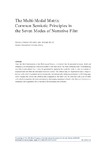The multi-modal Matrix: Common Semiotic Principles in the Seven Modes of Narrative Film

View/
Use this link to cite
http://hdl.handle.net/2183/13304Collections
Metadata
Show full item recordTitle
The multi-modal Matrix: Common Semiotic Principles in the Seven Modes of Narrative FilmDate
2012Citation
Culture of communication / Communication of culture, 2012: 2123-2131. ISBN: 978-84-9749-522-6
Abstract
[Abstract] From this brief introduction to the Multi-modal Matrix, it is hoped that the potential richness, depth and complexity of compositional choices available to the film-maker has been communicated. Understanding how film is articulated, how it may be generated by applying the symbolic code, is seen as a means of empowerment for both the filmmaker and film viewer. The former may be empowered with a range of devices with which to generate more conceptually and perceptually intriguing statements in film language, which engage the viewer and prolong that engagement; the latter may be provided with a set of tools with which to negotiate the more perceptually-challenging meanings offered in the film text. Constructive comments and suggestions for co-operative developments are welcome.
ISBN
978-84-9749-522-6





